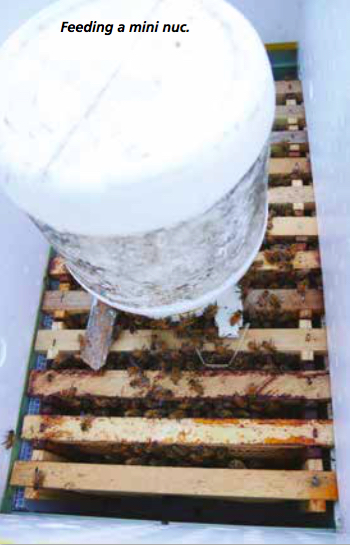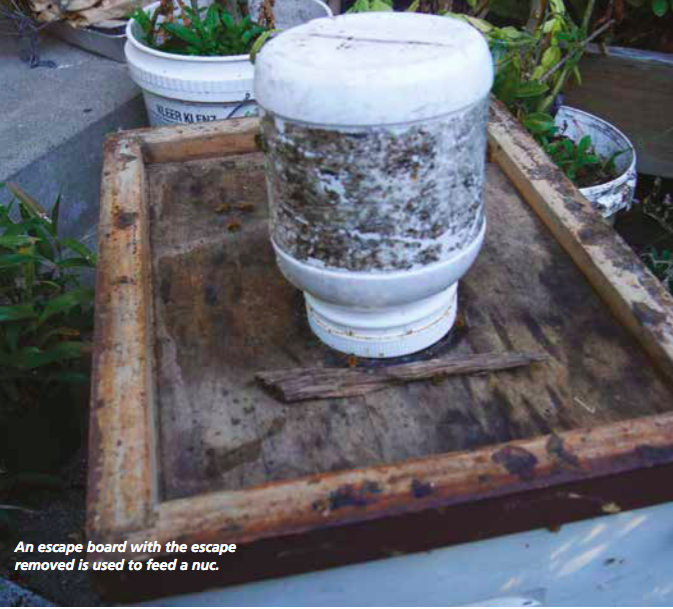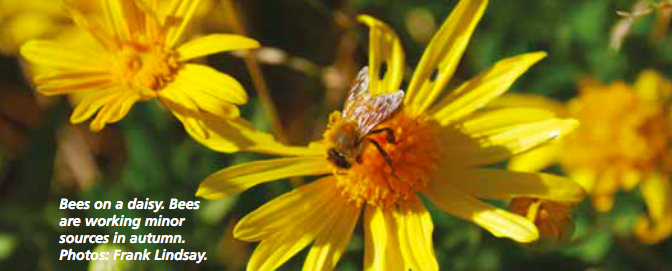
About the Apiary
An informative and sometimes humorous column published in
The New Zealand Beekeeper Journal
WINTERING DOWN AND PREPARING FOR SPRING
About the Apiary - May - 2016The last of the autumn sources have just about finished and now we are seeing early wintering sources budding up on the warmer section on the coastal strips. The bees are bringing in the last of the pollen as the days get shorter and colder. Some are working willow aphid honey dew, which is not totally digestible on its own in the hive. Hopefully there will be a number of frames of real pasture or bush honey to support the bees. The drones are being pushed out of the hives, which signals the end of the season.
Going into winter we have new queens in our hives and hopefully they are full of young, mite-free bees. What we need now is heavy hives. Two full-depth or three three-quarter- depth boxes should be a struggle to lift off the ground using one handhold, while standing to the side of the hive. This method of testing a hive’s weight is called ‘hefting’. If you want a more accurate measurement, use scales (I recommend Fischer’s Nectar Detector® scales: nectar-detector.com).


Feeding light hives
For those who took off the honey in February, leaving a full box of honey, you may be in for a surprise as the hives could be light. The bees could have gradually used all the stores because there have been minor flows: not enough for the bees to store anything, but these have stimulated brood rearing. Young queens tend to continue to lay longer than old queens. They have a burst of laying activity initially, which then tapers off when pollen and nectar become scarce. However, in some cases young queens will continue rearing a bit of brood all winter. Brood rearing uses a lot of food; hence the need to check the weight of hives periodically through the winter and especially in early spring (August).
The solution to boost a light hive is to feed a 1:1 ratio by weight of sugar to water, or fill a pot seven-eighths full of sugar, add boiling water to the top, and stir until all is dissolved. Feed while the syrup is still warm: five litres at a time in the late afternoon when most of the bees have ceased flying to prevent robbing. A strong hive will take this down in a couple of days and may need to be fed four or five times until the bees have stored a super of honey.
You will need to take several considerations into account if hives need a lot of feeding:
• the bees will use body fats to convert the sugar into honey, which will shorten their lives.
• there is a chance that uncapped honey could ferment during the winter, so add 1% acetic acid. Some books mention tartaric acid.
• the initial feeding will stimulate brood rearing but if fed in volume and constantly until the desired amount is achieved, it may be advantageous as the hives will produce another generation of winter bees.

Points to note when inspecting hives
Another important thing to do this month is to measure the number of mites in the hives, either using mite fall or using a bee wash. We all have to know that the hives have been treated successfully and that mite numbers are now low; i.e., less than one percent.
As a general rule, after robbing has finished we should also inspect the strongest and weakest hives for disease. The strongest may have robbed another hive; the weakest could be suffering from disease.
Close down the entrance to 100 mm by six mm (or even half this if there’s been robbing), and to just a couple of bee widths for nucs if they don’t have robbing screens installed. The idea is to exclude strong winds and mice wanting a nice warm winter home full of food.
Make sure that the hives are sloping slightly forward (maybe 20 mm) by lifting the back of the hive with a piece of timber. This will allow any rain to run off and out of the hive. It also makes it easier for the bees to remove any older bees that die off during the winter.
I prefer to put some insulation under the roof of the hives, as most of the heat generated by the bees goes upwards and out. Water vapour given off by the bees can accumulate under the crown board/split board and if there is sufficient moisture, it can rain down on the frames and bees, causing the frames to go mouldy and forcing the bees to consume more winter stores. I use the split board entrance to ventilate moist air.
The same effect can be produced by placing a drawing pin or a matchstick between the top super and the crown board, which provides a little ventilation. If there’s too much ventilation, the bees will seal it off with propolis.
Now we are set for winter and the coming spring. Observation is the most important attribute you can use in your beekeeping. We don’t want to needlessly disturb the hives but would like to know what’s going on inside. By reading the book At the hive entrance (Storch, 1985), we can get an idea of what’s going on inside the hive by observing the bees at the entrance. For those who can’t get hold of this book, there’s a free PDF that can be downloaded.
Preparing for spring
With most of the outside work done, our thoughts turn to the spring and the requirements for the coming season. Some new beekeepers will have had a successful first season. The bees will have built up and produced enough to winter over on (12 frames of honey and three to four frames of honey and pollen), plus one or two frames as a surplus for your table.
In the next season you will start with a full- sized hive raring to go in the spring. Another three supers for honey will be required for each hive. The bees are going to use some of next season’s honey to get them fully drawn and ready for the bees to use, so full production is only obtained when all your frames are built out.
Make a plan detailing everything you need down to nails, and give yourself a timeline to have everything finished by early spring. Any time lost during winter can’t be made up during spring, if you are a commercial operator, as you just don’t have the time. Order your new equipment now so you have it on hand when you want it.
Things to do this month
Winter down, check mite kill, dispose of honey (prices have increased again this season, probably as a result of our dry summer). Grade and sort combs into brood, extracting and damaged. In fact, all frames these days should be as white as possible.
Control wax moth and get on to it quickly. Queen failure nucs left for just a month are now full of wax moth larvae. (It was interesting to see the number of wax moth hanging around hive entrances while applying formic acid to some hives after dark.) A few beekeepers are shrink- wrapping pallets and freezing them for a few weeks in the local coolstore.
Check for wasps. They are building up on willow aphid dew and have robbed out a few on my weaker hives. Control the growth around hives, including some of the branches that may have grown over the hives during summer. Hives do best during the winter in all-day sun.
Pine needles have been falling for the last month. Collect a sack full and allow them to dry over the winter in a shed, ready to use in the spring as smoker fuel.
Start planning for the coming season. Drone production should start 50 days before they are required for mating. Order plastic frames well ahead of time to give them time to air. The thicker the wax, the quicker they are drawn. This will also give our suppliers something to do during the winter.
Register all your apiaries. The legislation requires unregistered apiaries to be burnt if not registered within 30 days.
Register for conferences: here in New Zealand, and/or any of the five in Australia and several in the USA. Also, plan to register for Apimondia in Turkey 2017 and Montreal in 2019. It’s worth the investment. The returns are in networking, learning and it could be a valuable marketing opportunity. Also it may be tax deductible. It just takes one idea that could pay dividends over the next decade to make this sort of investment worthwhile.
Reference
Storch, H. (1985). At the hive entrance: Observation handbook. European Apiculture Editions.
Frank Lindsay